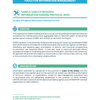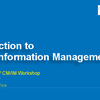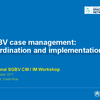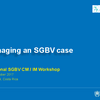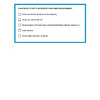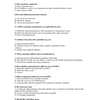SGBV - Child Protection Case & Information Management Tools
Sample SGBV/CP Regional Information Sharing Protocol (RISP)
This regional information sharing protocol is to set out the guiding principles and describe procedures for sharing anonymous aggregated data on reported cases of sexual and gender-based violence (SGBV) and children at risk within the Region.
Regional Information Sharing Protocol Implementation Action Plan
Coordination, Planning, Implementation, Maintenance
Sample SOPs for SGBV Data Processing
The SGBV module is a case management tool for UNHCR and partner Protection staff with responsibility for SGBV case management. User access rights for the SGBV module in proGres v4 are limited and, in each operation, the UNHCR Protection Officer at national level is responsible for reviewing each request for user access before approval is granted.
Consent for Release of Information
This form should be read to the survivor or guardian in her first language. It should be clearly explained to the survivor that she / he can choose any or none of the options listed.
Sexual and Gender-Based Violence (SGBV) incident classification tool
The humanitarian community has not been able to collect, classify and analyze Sexual and Gender-Based Violence (SGBV) -related information in a way that produces comparable statistics. At present, it is nearly impossible to compile and analyze data across programs and field sites. This cannot be solved without taking a new approach to how types of GBV are classified. To address this problem, the UN High Commissioner for Refugees (UNHCR), the UN Population Fund (UNFPA), and the International Rescue Committee (IRC) have developed a new SGBV classification tool strictly for the purposes of standardizing SGBV data collection across SGBV service providers.
Guidance on the use of Standardized Specific Needs Code
Note: Multiple needs codes may be used per individual. Those with a tick mark in front of the codes are specific needs that can be identified with minimal training. They can be collected with very little complication during mass registration exercises.
Regional SGBV / Child Protection Case Management- Information Management Workshop
Training content and materials are based on and adapted from existing UNHCR and IASC guidelines and tools, some of which were used throughout the training. It is highly encouraged to adapt the training to your specific context and needs.
Data Management in the Americas
Individual Data Management, Registration and Identity management, Regional situations and plans
SGBV Core concepts
Discuss the differences between SGBV and other types of violence. Recall the causes and consequences of SGBV. Identify strategies to prevent SGBV.
Handout Types of SGBV
Six Core Types of SGBV
Handout SGBV consequences
SGBV consequences can be multifaceted and can have major impact on adult or child survivors; families; and the community.
Handout Questions about sexual violence
It’s an exercise to put ourselves in the place of the other, understanding the reactions, the emotions, the attitudes, from a very personal vision, but it could help us to see the patient we assist, the one who is in front of us.
Working with SGBV survivors
Identify SGBV disclosure strategies. Describe SGBV guiding principles for working with survivors. Define SGBV case management and core multi-sectoral services.
Handout Being Respectful
Being Respectful, Do, Do not
Handout Essential Actions Reducing Risks of SGBV
Essential Actions Reducing Risks, Promoting Resilience and Aiding Recovery throughout the Programme Cycle
Handout the Role of a Case Manager
The role of a case manager includes
Introduction to SGBV Information Management
Describe what is meant by SGBV /CP Information Management. Identify global ethical standards and good practices. Explain the challenges. Explain how GBVIMS (also in proGres v4) can be used for data collection and analysis
Handout Understanding the Challenges in SGBV
Handout SGBV Information Management
SGBV case management: coordination and implementation
Learning objectives: Define referrals and transfers of cases; Identifying other coordination and implementation strategies and techniques; Experience how a case conference functions.
Managing an SGBV case
Learning Objectives: Describe case management steps; Discuss informed consent and mandatory reporting; Conduct an interview with an SGBV survivor and conduct a needs assessment.
Action Plan Template
Action points / goals; who; by when
Handout SGBV CM Checklist
Checklist Step 1: Introduction and Engagement
Handout IPV risk assessment
Question / Risk
Handout Key Messages to Share with IPV Survivors
Providing survivors with accurate information about intimate partner violence (IPV) and its impact can help reduce their self-blame and shame, and can help them better cope with what happened.
Handout Introduction and Engagement
Checklist Step 1: Introduction and Engagement
Best Interests of the Child in SGBV case management
Session objectives: Define the child’s best interests principle; Explain why are Best Interests Procedures needed; Identify the difference between Best Interests Assessment (BIA) & Best Interests Determination (BID)
BIA BID training Quiz
BIA / BID Quiz
Documenting SGBV and Child Protection case management
Learning Objectives: Clarify why it is important to document, how to document and which forms to use for SGBV CM and Child Protection CM in different situations. Identify other protection risks and how to capture them during the assessment step.
Handout: Protection Risks and SGBV Case Prioritization
Risk Level: Level 1 Emergency, Level 2 Urgent, Level 3 Moderate.
Self Care
Learning objectives: Discuss some of the personal challenges experienced by staff working with SGBV survivors. Learn a few simple techniques on how to check in with yourself on a regular basis.
Handout Self Care Managing Stress
Sources of streff; Strategies.
Referral Pathways
Venezuela
Handout UNHCR Data Protection Policy
UNHCR Data Protection Policy 2015: Key points for UNHCR, implementing partners and third parties
UNHCR Data Protection Policy 2015
Review key elements in the UNHCR Data Protection Policy. Reflect on data protection measures in place in your organization using the Data Protection Checklist.
Identifying Data Points
Understand what amount of data can be the most useful at field, national and regional levels. Identify a common set of data points that would be useful for data sharing purposes across the region (regional Information Sharing Protocol).
Introduction to the SGBV and CP modules in proGres v4
Explain who has access to the SGBV and Child Protection modules in proGres v4 and when use of the modules is appropriate. Share overview of how the proGres v4 security model works and how user access is granted. Understand how the case management process and work flow fits with information management in proGres v4.
Referrals and Transfers of Cases in proGres v4
Distinguish between referrals and transfers. Clarify the points in your work flow when a referral or transfer of a case would take place.





